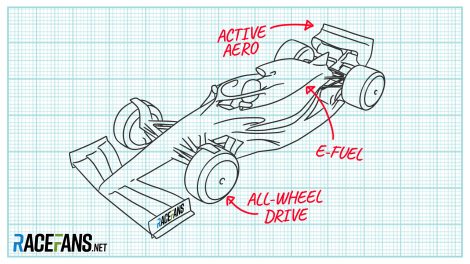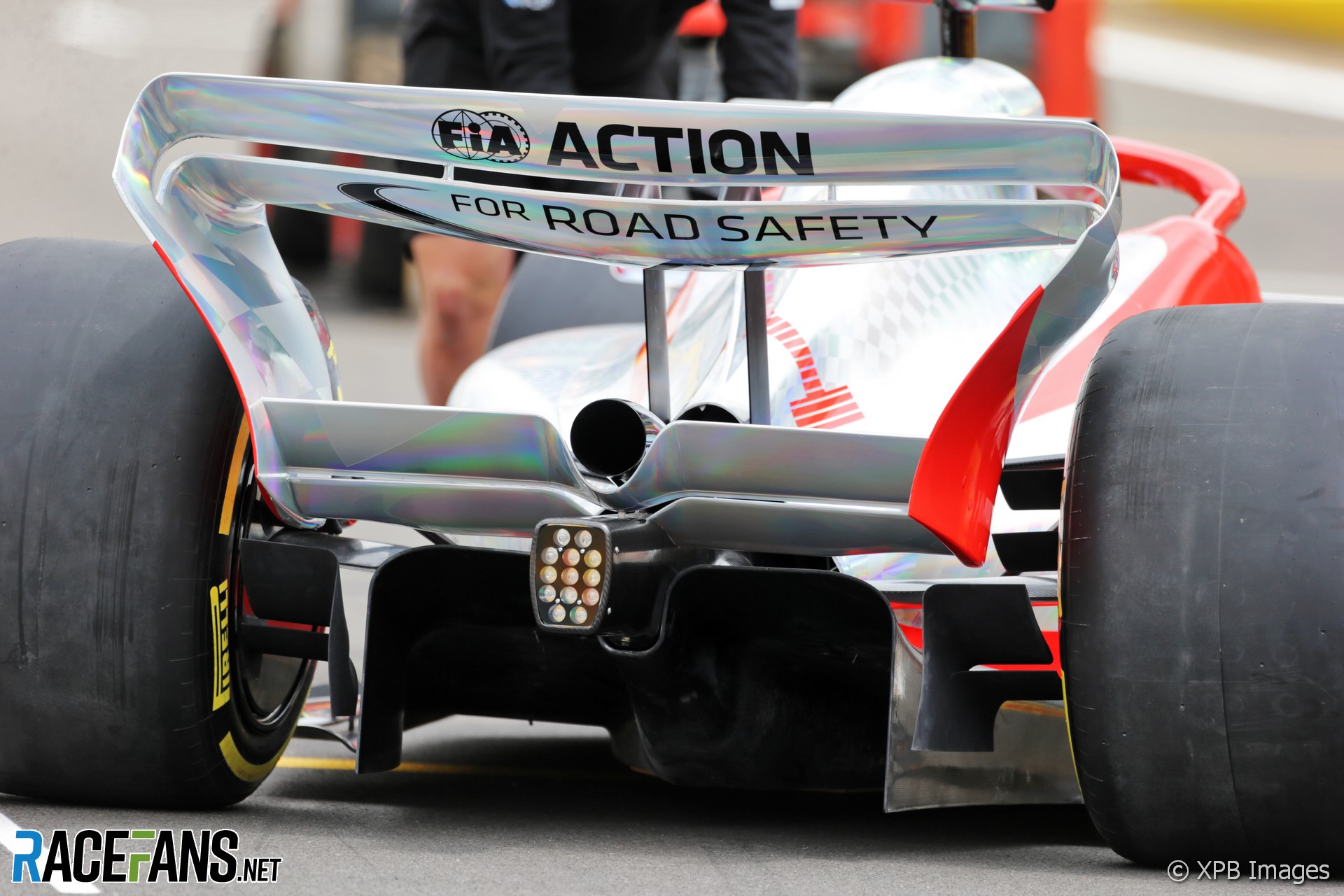Formula 1 plans to reduce the dimensions of its cars in 2026 when it overhauls its technical regulations again.
However a long-awaited reversal in the trend towards heavier cars is unlikely according to F1’s motorsport director Ross Brawn.F1 increased the maximum width of cars to two metres in 2017. This reversed a change introduced in 1998, when cars were narrowed by 200 millimetres to 1.8m. Lewis Hamilton said his 2017 car looked “like a boat” when he first laid eyes on it.
While the cars’ height remains fixed, chassis length is not set down by the rules. As a result cars have become progressively longer in recent seasons as teams seek efficient packaging for bulky hybrid power units and use elongated bodywork to generate more downforce.
As a result cars have extended by more than a metre since the mid-noughties and now typically measure over five-and-a-half metres from front to rear.
The minimum weight limit has also risen during that time, notably in 2014 when the V6 hybrid power units were introduced. New technical regulations for next season will see the minimum weight limit climb again, by 40 kilograms, to 792kg.

The current generation of cars “are big”, Brawn conceded, and said F1 hopes to address this when it introduces new cars and power units in five years’ time (originally planned for 2025). However he admitted it may not be possible to bring the weight limit down.
“As you know we’re looking at a new power unit for 2026,” said Brawn, “and a new car will go with it and that’s some of the primary objectives: Can we save weight, which is challenging with a hybrid car and with the safety initiatives we’ve got on the cars these days; Can we have a lighter car? Certainly can we have a smaller car, we believe we can.
“We think with the spec that’s evolving for ’26 there’ll be a very real chance of having a more compact car.”
Many F1 drivers have criticised the trend towards heavier cars. Hamilton said in June the rising weight is at odds with the series’ push to improve its sustainability.
“As we get heavier and heavier, that’s more energy we’ve got to dissipate, bigger brakes, more brake dust, more fuel to get you to the location, and so on,” he said. “I don’t fully understand it.”
Advert | Become a RaceFans supporter and
F1’s minimum weight limit, 1961 – 2022
NB. Separate minimum weight limits were enforced for turbocharged and normally-aspirated cars in 1987 and 1988.
Advert | Become a RaceFans supporter and
2026 F1 season
- Alonso set to become F1’s oldest driver for more than 50 years
- F1’s 2026 cars will have 1,000 horsepower, less downforce and weight – Symonds
- Audi announces ‘expanded commitment’ to F1 and full takeover of Sauber
- Silverstone announces new, 10-year Formula 1 grand prix deal
- Suzuka secures its place on F1 calendar until 2029 with new deal





Jere (@jerejj)
2nd November 2021, 11:11
Just go for a smaller fuel tank size, & if necessary for this, shorten the races.
Reducing overall tank capacity would automatically shave off some weight w/o taking away any safety measures.
All races could have the lowest lap count needed for reaching 260 km a la Monaco (Singapore should have that anyway). Races would still be long enough for proper racing & strategic options.
For example, Super Formula races are shorter than Monaco GP (& longer than F2 feature races) & still have enough laps for the above two. 305 km has been the standard for a while, but not a definite must.
gardenfella (@gardenfella72)
2nd November 2021, 12:05
@jerejj there’s a big gap between the engine and gearbox so it’s not all about needing space in there. The fuel cell is in the monocoque, largely underneath the driver.
The cars have been extended for aero purposes and one of the driving factors behind this was the increase in width that came about in 2017.
S
2nd November 2021, 12:19
Yes! Smaller fuel tank requires the re-introduction of refuelling. F1 was always more interesting with the additional strategic element.
Bradders (@bradders)
2nd November 2021, 12:53
No. It’s was dull and discouraged on-track overtakes.
S
2nd November 2021, 13:33
Take DRS away and what do we have? Same as before with refuelling.
Don’t attribute one problem with another. There was ‘no overtaking’ because the cars were simply rubbish race cars, and still are.
MacLeod (@macleod)
2nd November 2021, 13:55
I think we have to wait untill we see 2022 and it overtaking is much beter we can remove DRS. Refuelling is something of the past and will never return too dangerous.
anon
2nd November 2021, 19:36
S, the data from the 1990s for the periods before and after the introduction of refuelling does provide evidence of a causative link between the introduction of refuelling and a decline in overtaking on track.
As other former and current engineers in the sport have pointed out that, rather than adding strategic variety, refuelling tended to do the opposite and reduce variety.
At most circuits, there were very few alternative refuelling strategies that were viable – there is a tendency for some to point to the handful of extreme examples of unusual refuelling strategies, but they’re only remembered because they were so abnormal and thus there is an extremely strong selection bias. People might remember the one time that Schumacher ran a four stop strategy, but they won’t remember the dozens of races that he won by using the same refuelling strategy as everyone else.
It also was fairly easy for engineers to work out in the opening laps of a race what strategy a driver might be on, and often be able to predict, plus or minus a lap, when they were going to pit. Equally, with the fixed fuel flow rates, you just had to time how long the refuelling stop was and you knew what strategy the driver must be on and when they were stopping again – it was predictable enough that commentators would often comment on what strategy a driver must be on from the refuelling stops, and some broadcasters would started showing predicted fuel stops for the higher profile drivers in their coverage.
S
3rd November 2021, 10:36
Refuelling isn’t too dangerous when it’s done in a safe manner @macleod – which it generally wasn’t last time it was in F1. Nor is it something from the past, as many many other series (including Indycar) do it, quite simply because it brings more positives than negatives.
Yes, thank you @anon. At least nobody knew for sure before the opening stint how much fuel their competitors had, nor how many stops they planned to make – given that they had more opportunity to substantially alter their strategy mid-race if desired, depending on track position, circumstance and competitor strategy.
Without refuelling, they know for sure that their competitors won’t be stopping for fuel, they know for sure how much fuel each car has and how hard they can push, and they also know for sure which tyres they’ve got on before the race starts, and that they’ll almost certainly be doing something very predictable (or something they can easily plan for) with the other set/s of tyres, based on what is left in their allocation and how each tyre is performing on track.
So why not give them the option to alter their weight (fuel load) and stint length with a relative performance benefit for more stops as they wish? They don’t need to do anything different, but they could if they wanted to.
I’m not forgetting how many races featured converging strategies – and there are at least as many now. I can also remember a lot more 2 and even 3-stop races – whereas now the vast majority are singles, and the majority of the field tends to do pretty much the same thing.
Track position is more important now mostly due to car design, but also due to the fact that no car can come out of the pits substantially faster than their competitors by running with a lower fuel load – nor can they run substantially longer than their competitors by running a heavier load. Everyone has (approx) the same fuel load, removing a variable that can create better and less predictable racing.
All your points about predicting strategy apply even more accurately without refuelling, as the sole remaining variable is tyres, of which they generally only run 2 of the 3 options during a race. And if they are coming off one of them at their one and only pit stop…
anon
3rd November 2021, 15:39
So, at best, your own argument basically only works for the opening few laps of the race? It rarely took more than that for teams to work out the fuel loads of another car, and it really isn’t hard to work out what the other teams were doing after that.
You like to claim that there would be all that variety – but where was that mythical variety in the past, and where is the evidence that any of that variety would happen in the future?
You even acknowledge in your reply that what really tended to happen was that most teams converged on the same strategy – when that is usually the fastest way to complete a race, why would you do something different?
S
4th November 2021, 10:14
@anon A few laps are better than none at all.
I’m not claiming that there would be a huge strategic variety every race – I’m ‘claiming’ that there would be more options available. Whether those additional options are taken up is a separate issue altogether – but at least they would be there for anyone who wanted to try them.
Why would you not allow the teams the option to do something different?
The cars are basically all the same, the engines are basically all the same, the tyres are all the same and so, consequently, the races tend to be mostly the same. That may still be the case with refuelling, but having additional options available makes more outcomes available, even if they aren’t used.
Notice the words I’m using – options and available. Not restriction and minimisation.
MacLeod (@macleod)
12th November 2021, 7:59
S, I think it come back when the fuel is harmless like water. It’s the speed of pitstop which makes refuelling dangerous every system you can made up can cause failure when things are to fast. So the system mustn’t get stuck or spray fuel and i have seen many systems but they always had problems.
Jere (@jerejj)
2nd November 2021, 14:10
@S Not if races were shorter. A decent amount of fuel for pushing over a full race distance without in-race refuelling.
S
3rd November 2021, 10:39
F1 is moving towards fuels with lower energy density @jerejj – if you reduce fuel capacity in addition to that reduced energy density – F1 would indeed be having only short races.
Sprint races…
They can’t even push for a full race distance now with potent fuels and a huge tank.
Dex
2nd November 2021, 12:21
I don’t want shorter races because of some technicality. I prefer watching races over analyzing weight of a car. That’s what we pay tickets for – on-track action. Sure, sometimes races end being “too long” when nothing happens, but sometimes interesting things do happen. Shorter races mean less chance to see some action. Hell, even without great events on-track I still enjoy watching them all go. We’ve seen this so-called “sprint” and it proved that less laps doesn’t mean more activity. As for the fuel for sprints they have their tanks much emptier and lighter, it didn’t change a thing for me as viewer. It looked pretty much like any other race, just without proper motivation to take risks.
Aapje (@aapje)
2nd November 2021, 11:16
It’s always a lot easier to go from small to big, than from big to small. It’s like moving into a smaller home. Suddenly you discover how much crap you have.
A lot of the safety demands and equipment that was introduced may be hard to accommodate if the car is substantially smaller.
Yaru (@yaru)
2nd November 2021, 11:27
That is probably why they’re trying to plan for it now alongside that new powerunit spec.
Sensord4notbeingafanboi (@peartree)
3rd November 2021, 3:16
It would aid safety if the weight was to be reduced.
Slimmie205
2nd November 2021, 11:37
They desperate need to reduce the weight. Smaller cars and less weight is what F1 needs. I love the nimble cars from 2006-7 for example.
MacLeod (@macleod)
2nd November 2021, 13:56
those were nor nimble the cars of 1960-1965 those were nimble.
Rhys Lloyd (@justrhysism)
12th November 2021, 2:33
@macleod and deadly. Can’t have both.
MacLeod (@macleod)
12th November 2021, 7:52
@justrhysism, Your ofcourse right but that’s the era i became a fan of the Lotus 25 (also i was place in the seat of that car by a certain gentleman called Jim is hard not to be :) )
S
2nd November 2021, 12:16
The cars need to be smaller, lighter, simpler and cheaper. And there should be more of them.
János
2nd November 2021, 15:19
Yes!
Yaru (@yaru)
2nd November 2021, 15:49
Like FE cars then?
SteveR
3rd November 2021, 0:56
I think F3 cars are faster than FE, but FE never races on a track where times can be compared. Rather watch FF than FE.
steveR
3rd November 2021, 1:23
can’t of course.
Omar R (@)
3rd November 2021, 2:09
@yaru he didn’t say slower.
MacLeod (@macleod)
3rd November 2021, 8:08
I don’t think FE stays slower the developments gets beter and beter with the years. The question will be more will they allow faster cars…..
UNeedAFinn2Win (@uneedafinn2win)
3rd November 2021, 10:26
FE has banned development. That’s the reason for the major OEMs quitting the sport lately
S
3rd November 2021, 11:59
Slower is fine with me, @omarr-pepper.
I’m definitely of the opinion that many of F1’s problems stem from being too fast – or to be more accurate, from their unhealthy obsession with being the fastest, and the way they produce that speed.
I’d rather FE be FE, and F1 be F1. They are centred around different philosophies, and hopefully it will stay that way.
F1 can be all the things I mentioned without being FE, F2, Indycar, Super Formula or anything else. It was before…
All it takes is a strong enough desire to make it happen.
petebaldwin (@)
2nd November 2021, 12:40
Sounds like Lewis have not been convinced yet by the heavier cars. He’s indifferent….
Still, he drives the car so he must love the fact that it’s heavy.
Yeah… heavy cars. The drivers all want heavier cars. Make them heavier!
SadF1fan
2nd November 2021, 13:08
Now that there is a budget cap, a minimum weight limit seems redundant, and limits the options for choosing R&D paths.
MacLeod (@macleod)
2nd November 2021, 13:59
Heavier is not a bad thing my question why is it 40kg heavier i would expect the 2022 car would be lighter then the old car. The tyres were 9kg heavier? is that per tyre or with 4 tires?
Sacha Gortchakoff (@gosac)
2nd November 2021, 14:00
you cannot disappoint us anymore !
we understood that the aegis of wisdom / the principle of M A X I M I S A T I O N is over !
(and we understood that the principle of M I N I M I S A T I O N does not make sense in sports ;)
Lamalas (@lamalas)
2nd November 2021, 14:34
Wasn’t the minimum weight introduced for safety reasons + to reduce spending on exotic matrials?
Yaru (@yaru)
2nd November 2021, 15:51
Pretty much but it also has to be adjusted based on the spec regulations.
MacLeod (@macleod)
3rd November 2021, 8:10
Yes to prevent the rich team to use very expensive matrials to get weight advantage. Also for some safety feature Halo and sidebars for example.
Ruben
2nd November 2021, 14:59
Yes you can, just put it in the regulations. Lower the mininimum weight and teams will pursue it.
And it’s a minimum weight, so you don’t have to run a lighter car if you don’t want/or can’t make it that light. The choice is up to the teams.
Yaru (@yaru)
2nd November 2021, 16:01
It’s partly to help ensure cost parity so teams don’t go crazy on super light materials.
Which sound like it should be a “who does it best, benefits” thing except all the teams are in favor of increasing it.
Yaru (@yaru)
2nd November 2021, 16:02
*I should note, as far as the new 2022 chassis rules are concerned. Not whatever thing they have planned in 2026.
Ruben
2nd November 2021, 21:51
But don’t we have a cost cap for these issues very soon? I’m up for all teams having the same budget and then letting the teams decide where to spend their money.
Naturally, in that case it’s more of a strategic decision: where do you put your money and how easy can you still back out of a concept if it turns out it doesn’t work at the first day of testing.
Also, from what I understood, (some?) personnel cost isn’t part of the budget cap? So maybe that still gives the wealthy teams a chance to poach all the smart people away from the other teams…
S
3rd November 2021, 12:05
So are most people who don’t run F1.
Except that it might decrease on-track competition and close racing, so it’s not desirable in this new age of F1.
Correct, which is why the same big teams will remain at the front, and the same small/poor teams will remain at the back.
Patrick (@paeschli)
2nd November 2021, 18:17
They should put the width at 1.8m and look up whoever had the longest car in 2014 and make that the maximum car length.
Then also reduce the minimum weight by 50kg and we might have a winner on our hands.
NS Biker (@rekibsn)
3rd November 2021, 2:33
Making the cars smaller won’t reduce the weight significantly. A little, but not much.
In the last few years, every time some feature is added to the cars, the Halo, MGU K and H, batteries, additional safety impact standards, DRS, stiffer wings, to flag a few, they have added to the minimum weight.
With the new cars having heavier wheels, spec aero over the wheels and wheel covers, it all gets added to the minimum. Next is 4 wheel drive, moveable aero, more battery, energy recovery from the front wheels and these cars will blow past 2,000 Lbs.
They may have to hire really heavy Jack Men for pit stops. Like Nascar teams.
S
3rd November 2021, 12:08
If they go with All Wheel Drive and movable aero there’ll be no point watching for anything the drivers do, because they certainly won’t be having much influence.
They have too little influence on combined performance now.
Pinak Ghosh (@pinakghosh)
3rd November 2021, 11:29
To put the 40 KG in perspective, there would almost be another Yuki Tsunoda in the car!
Adding weight without increasing power output probably wont make racing more exciting. But if the aerodynamic changes encourage overtaking, which is probably the key focus area for the change in regulations, then it would matter less.
Dan G (@dang)
3rd November 2021, 13:31
It’s silly to stoke this debate. The cars are heavier to keep drivers alive after crashes. Do you we really need to see F1 drivers dying again? NO.
This “nimble” stuff is nonsense; outside of your dreams you aren’t driving the cars and from the outside, these cars are changing direction and cornering faster than ever before.
I’d certainly like to see the cars back to 1.8m width and a length limit of 5m, if not less. I don’t really understand why the tyre walls were left so high with the switch to 18″ rims; I expected visibly low-profile tyres. (Maybe it was a looks thing? More “traditional” to keep tall tyres?) Fair bit of weight could be cut there.